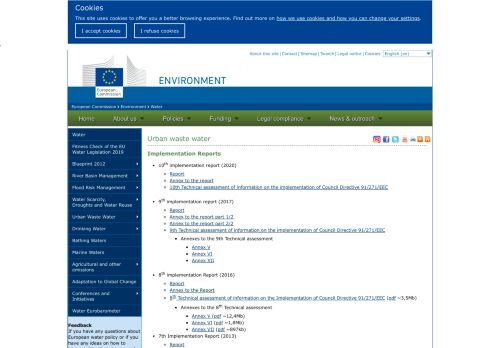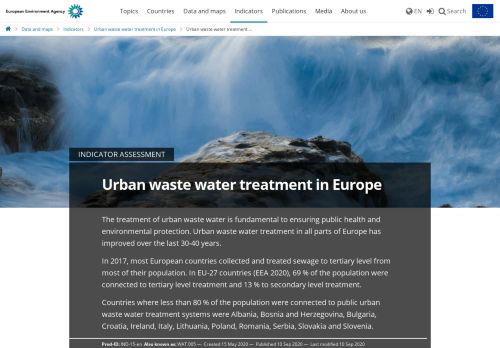
Voice of the Danube
The European Commission has published the 10th report on the implementation of the Urban Waste Water Treatment Directive (UWWTD). It is part of the Commission's zero pollution efforts and comes ahead of the Chemicals Strategy which will be adopted in the coming weeks.
The report covers over 23,500 EU towns and cities that fall under the scope of the Directive, where people and industry generate over 610 million population equivalents, or around 490 million bath tubs of waste water, per day.
Overall, compliance rates with EU waste water collection and treatment rules are high and have increased compared to the previous reporting period: The report shows that 95% of waste water in the EU is collected and 88% is biologically treated. While the trend is positive, full compliance with the Directive has not yet been achieved, with 1% of urban wastewater still not collected at all, and over 6% not sufficiently well treated to meet secondary biological treatment standards.
The current level of investments in many Member States is too low to reach and maintain compliance with the Directive in the long term, with several EU towns or cities still needing to build or modernise their infrastructure for collecting wastewater, as well as to put modern treatment plants in place.
EU Commissioner for the Environment, Fisheries and Oceans Virginijus Sinkevičius said:
“This report confirms that the collection and treatment of waste water is improving all over the EU. The EU rules have played a crucial role in improving the quality of the rivers, lakes and seas on our continent, with a beneficial impact on European citizens' health and quality of life. However, progress has not been even and in some EU Member States waste water infrastructure needs better planning and more financing. We will now do our utmost to drive innovation and new investments in environmental infrastructure everywhere in Europe.”
A recently published OECD study provides the European Union with a clear picture of investment gaps. The Commission will work with the relevant Member States to make the best use of the opportunities offered by the new Multiannual Financial Framework and the Recovery Plan for Europe by including water treatment and sanitation as a top priority.
The Commission has also launched an impact assessment to evaluate different policy options with the aim of modernising the Directive. This involves, amongst others, searching ways to deal with contaminants of emerging concern such as pharmaceuticals and microplastics, and considering regular waste water surveillance options to enhance the EU preparedness in managing the COVID-19 pandemic, or similar diseases. This impact assessment will involve a considerable amount of consultation with relevant stakeholders.
For More Information please consult the links below.
Urban waste water - Environment - European Commission
Urban waste water
The treatment of urban waste water is fundamental to ensuring public health and environmental protection. Urban waste water treatment in all parts of Europe has improved over the last 30-40 years. In 2017, most European countries collected and treated sewage to tertiary level from most of their population. In EU-27 countries (EEA 2020), 69 % of the population were connected to tertiary level treatment and 13 % to secondary level treatment. Countries where less than 80 % of the population were connected to public urban waste water treatment systems were Albania, Bosnia and Herzegovina, Bulgaria, Croatia, Ireland, Italy, Lithuania, Poland, Romania, Serbia, Slovakia and Slovenia.





